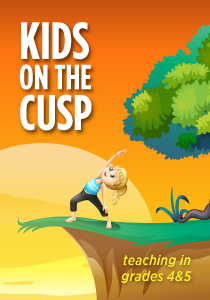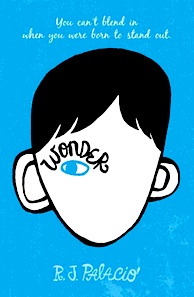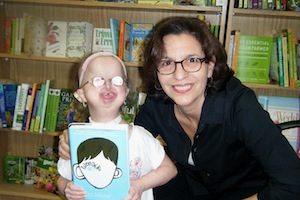The Wonder of Passion-Based Learning

In other words, kids need to feel passionate about what they are learning. I couldn’t agree more.
Storytelling, in its richest form, has an incredible impact on children. Listening to stories can reach far beyond exploring story elements. A book that stirs our emotions allows us to teach language arts topics while instilling deeper understandings and connections to the outside world inside every learner.
This truth became quite apparent during our most recent fiction unit. The read-aloud book I chose ignited passion in my students. It was a brand new read-aloud (well, it was new to me). I had never even heard the title until it appeared on my son’s required summer reading list.
Every sixth, seventh, and eighth grader was required to read it before entering school in the fall. Whoever made this decision was really onto something. It was a big idea…an inspired move.
A boy named August

August’s story harnessed their emotions. The entire class was hooked from page one.
I saw them have the same reaction to that first page that I’d had, when I was reading my copy on our living room couch this past summer. (My soon-to-be seventh grader had been simultaneously enmeshed in Wonder under the covers in his top bunk.)
Throughout the unit, each and every member of our class had an intense response to August’s story. And we explored some deep-thinking activities, deeper than I had anticipated.
Palacio’s story lends itself beautifully to discussing how the use of first person narration impacts a story. In order to effectively analyze all of the characters more deeply, the reader must have a conscious awareness that they are only seeing the narrator’s interpretation of events.
Making predictions, understanding motives, analyzing characters, and looking for clues within a story are all trademarks of good reading. Understanding the impact that first person narration has on the story takes the analysis just a bit deeper. This is not an easy connection to teach, but Palacio made it easy to analyze and discuss these differing versions of the same event.
My reluctant writers had lots to say
Her novel is broken into sections. The first portion of August Pullman’s life is told entirely from August’s perspective. While reading this section, I assigned a variety of reading notebook responses. I asked students to describe a scene from the story, to write (from their perspective) about how the other kids treated August, about August’s relationship with his family and those close to him, and about what it feels like to have trouble fitting in because you are different. I asked them to find similarities between themselves and all the characters in the book.
They wrote. Even my reluctant writers wrote. They had a lot to say. They felt very strongly about what was going on in the story….passionate, in fact.
I asked them what they thought the other characters were thinking and feeling as we approached the end of the first segment of the book and prepared to begin the part where August’s voice takes a back seat.
In the sections that follow, the story is told through different sets of eyes until, in the end, we return to August’s perspective. (Here’s a summary of all chapters.)
From many perspectives
The kids had the most fun with the reading responses that asked them to become the other people in August’s life. They discovered, first-hand, the impact the narrator has on a story.
Julian, our antagonist, is incredibly cruel. He is the meanest kid at school. Julian is the kid who, as one writer explained, “makes you want to reach into the book and rip his face off.” (I’m not a promoter of violence, but I would say this shows passion about the topic).

R.J. Palacio with a young fan.
Reaching inside for their “inner jerk” and writing from Julian’s perspective was quite an exercise in creative thinking. You could feel the anger and disgust in their responses as they described the plot from Julian’s point of view. Kids can be so mean to each other, fictional or not. It’s sad, but true.
Their writing also included an enormous amount of sympathy and empathy. Via, August’s older sister, is scared of her own feelings as she discusses some of her negative responses to having August as her brother.
Summer, one of the many heroines in the story, befriends August immediately and has the ability to see past his face. Jack Will, a classmate struggling with the choice between fitting in with the crowd and discovering what it means to be a true friend, is another voice that my readers embraced as we followed August through the halls of Beecher Prep.
The first person versions that my students created in their earlier writing responses met “the real” first person perspectives of Palacio’s characters. (NPR interview with the author.)
We covered a lot of ground, developed as readers, and came away with the clear wisdom of Palacios’ tale: “When given a choice, choose kind.”
Harnessed emotions led to learning
Many unplanned and unidentified objectives were met during this unit as well. I realized that August’s story had reached beyond the walls of our classroom as emails started coming in from parents. Five of my students had chosen to read Wonder again at home with a parent. “What did you do at school today?” had generated a deeper than average response.
I think Peter Skillen would agree that August’s story enabled me to use the strong emotions and reactions of my students to teach deeply. Rich literature and good story-telling give me a chance to harness those emotions discussed in his passion-based learning analysis.
I saw big ideas, big connections, and big questions being asked about treating others fairly, about the worth of popularity, about how hard it can be to do the right thing…lotsa’ life issues that can’t be explored in a non-fiction world in quite the same way. (Here’s an article about positive impact of fiction reading on brain function.)
As my students travel up the grade level ladder, and the Core Standards move from 50% literary-based to 70% information-based, I hope they will remember August’s story.
I hope they will try to see things from other people’s perspectives….I hope that, when given a choice, they will choose kind.
They sure seem to be off to a good start.
Here are some samples of their writing:





































Dear Mary,
Your post has certainly kicked some of my emotions into gear! :-) What an incredible story – well, really an incredible couple of stories! The story ‘Wonder’ by R.J. Palacio, is such a necessary tale to have a socially inclusive society. That is one story. The other phenomenal story really is about how you have been able to leverage ‘Wonder’ to elicit such strong responses from your students – oh yes, and to raise ‘scores’ as well. :-)
I am quite flattered and honoured to have been included in this post. Thank you so very much.
I am involved with an organization I think you will love. Check out Global Dignity Day. http://globaldignity.org is the global site. http://globaldignity.ca is the site for Canada we used last year. I plan to do more digital storytelling type stuff with kids and teachers in advance for this year. Maybe we’ll get to work together a bit on that? ;-)
Off to check out your Facebook site!
Your students are lucky.
Sincerely,
Peter
Thank you, Peter!…There’s that third story too, the one about how the book impacted me in my life outside of school!…What a book…I must say, my classes responses filled me with a passionate reminder of why I teach!…Digital storytelling?…I’m intrigued!…
Mary, Thanks for sharing your experiences and all the extra links for Wonder. I appreciate them all especially the summary links. Stay warm, Margie
Absolutely, Margie!…I hope you enjoy exploring it as much as I did!